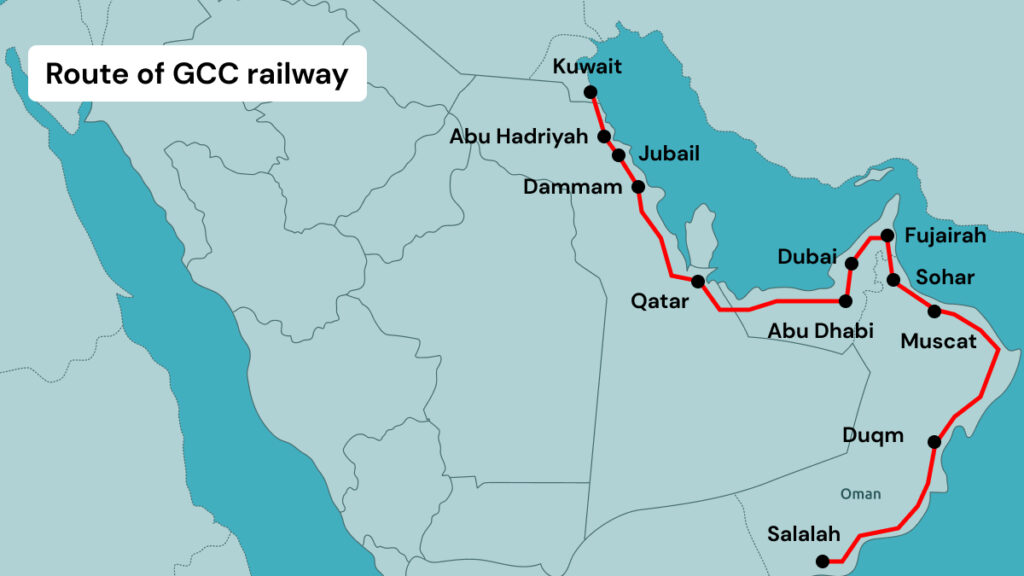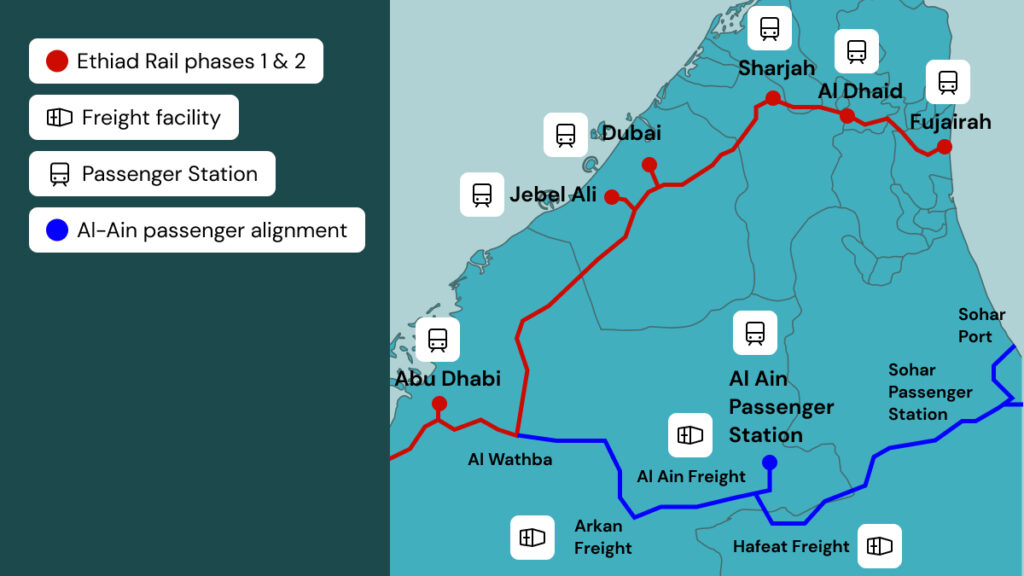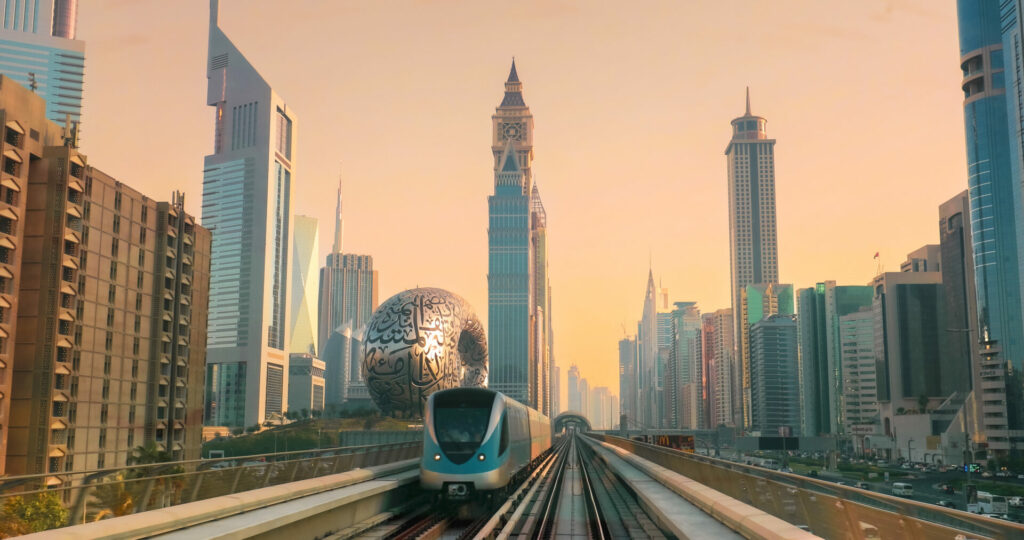Railways connect. They link cities, countries, and sometimes entire regions. In the Middle East, sustainable mobility has found its place on the rails, with Saudi Arabia, Kuwait, Bahrain, Qatar, the United Arab Emirates (UAE), and Oman all investing in railway projects. Today, there are more railway infrastructure projects in the region than ever before, encompassing both freight and passenger transport. In this article, we delve into some of the notable projects shaping the future of railway in the Middle East. Join us on this promising journey through the region!
The Gulf Cooperation Council (GCC) states have committed to establishing a comprehensive railway network known as the Gulf Railway or GCC Railways. This ambitious project aims to connect Bahrain, Qatar, Kuwait, Oman, Saudi Arabia, and the UAE over a total length exceeding 2,100 kilometers. Costs are estimated between 100 to 125 billion USD. The railway network is designed to integrate transport flows across the Gulf states, boost economic development, and reduce CO2 emissions. Each member state is responsible for the development and construction of its infrastructure.
Here’s an overview of the planned railway network:

Let’s examine some of the key projects within the GCC Railways initiative. A centerpiece is Etihad Rail in the UAE, a USD 11 billion project for both freight and passenger transport.
Etihad Rail: Railway Network in the UAE
The Etihad Rail network spans approximately 900 kilometers. It has been constructed in three phases:
- Phase 1: Since 2016, a 260-kilometer freight line connects the port of Ruwais to Shah, primarily servicing gas fields. It transports an average of 410,000 tons of sulfur monthly. Shifting freight to rail can reduce CO2 emissions by 70 to 80 percent. Rail transport of bulk goods is significantly more efficient and economical than road transport.
- Phase 2: This segment, which began in 2020, spans approximately 600 Kilometers. It is connecting the western and eastern regions of the UAE, passing through all seven emirates. Construction involved entities such as China Railway Construction Corporation Ltd., reflecting substantial Chinese investments in the Gulf region.
- Phase 3: Covering about 280 kilometers, the final phase serves the northern region. It is linking Ras al Khaimah, Saqr, and Khor Fakkan to the railway network.
In 2023, the expanded freight network became operational, linking all major ports, freight centers, and neighboring countries Saudi Arabia and Oman.

The continuous rail link reduces travel times by up to 40 percent compared to road travel. The journey from Abu Dhabi to Dubai now takes just 50 minutes. Annual projections include transporting around 16 million passengers and 50 million tons of freight. They will potentially be saving approximately 8.2 million tons of CO2 emissions per year.
Hafeet Rail: Connecting the UAE to Oman
Another cross-border project is the railway link between the UAE and Oman, known as Hafeet Rail. This 303-kilometer network will connect Sohar Port in Oman to the UAE’s national railway network in Abu Dhabi. From there, it will extend to all seven emirates of the UAE up to the border with Saudi Arabia.
This historic project aims to facilitate cross-border trade, enhance supply chain efficiency, and boost economic and social connectivity between the two countries. It integrates trade ports, industrial centers, and economic zones, fostering expansion across various industrial sectors and tourism.
To ensure fast and secure passenger and freight transport, Hafeet Rail will operate at peak efficiency and safety standards, adhering to international best practices. Trains will be equipped with the European Train Control System (ETCS) Level 2, the world’s most advanced system of its kind. Planning, construction, and integration are managed by a consortium comprising Siemens Mobility and Hassan Allam Construction.
Passenger trains are expected to reduce travel time from Sohar to Abu Dhabi to 1 hour and 40 minutes and from Sohar to Al Ain to just 47 minutes at speeds of up to 200 km/h for passengers and 120 km/h for freight. Hafeet Rail is operated as a joint venture involving Etihad Rail, Oman Rail, and Mubadala Investment Company, with project costs estimated at USD 3 billion.

High-Speed Rail from Kuwait to Riyadh
Saudi Arabia and Kuwait are set to establish a high-speed railway line by 2028. This ambitious 650-kilometer project will create a rapid rail link between the capitals of Riyadh and Kuwait City. Travel time will be reduced to just two hours.
The lines will connect with the Gulf States Railway, enabling passenger travel from Kuwait City to Dammam in Saudi Arabia at speeds of up to 225 kilometers per hour. Construction is scheduled to begin in 2025, with completion anticipated within three years.
The project is part of Kuwait’s National Rail Road System (KNRR). It is featuring an integrated railway network spanning 511 kilometers of double-track lines for both freight and passenger transport. Regional lines will achieve speeds of 120 km/h, while high-speed sections will reach 200 km/h.
King Hamad Causeway: Bahrain to Saudi Arabia
The King Hamad Causeway project will connect Bahrain and Saudi Arabia through a new track parallel to the existing King Fahd Causeway.
This 57-kilometre-long railway line will relieve the current route with over 10 million passengers per year.

The railway will link the future King Hamad International Station in Ramli to Dammam Station in Saudi Arabia. Dammam Station will connect to all national rail lines in Saudi Arabia. The passenger terminal at King Hamad International Station in Ramli will integrate with Bahrain’s planned metro network, linking to Bahrain International Airport and various business and residential areas.
Luxury in Saudi Arabia’s “Dream of the Desert”
In Saudi Arabia, by far the largest Gulf state, there are a number of infrastructure projects that would be worth an article of their own. Let’s leave it to others to describe how the largest Gulf state by far will triple its railway network. Instead we present a project of a completely different kind: The “Dream of the Desert”.
In March 2023, Saudi Arabia Railways signed a Memorandum of Understanding with Italy’s Arsenale Group to launch the region’s first luxury train. Scheduled to commence in 2025, this train will feature 40 deluxe cabins, offering journeys from the capital Riyadh to Qurayyat at an investment exceeding USD 51 million.

Mit dem Laden des Videos akzeptieren Sie die Datenschutzerklärung von YouTube.
Mehr erfahren
What’s Driving the Rise of Railway in Middle East?
The growing significance of railways aligns with the impressive economic development of the past 15 to 20 years. Middle Eastern countries are preparing for a future where reliance on oil and gas diminishes in major global economies.
Their goals include advancing their own economies, participating in global transportation flows, and creating local value. Moreover, these efforts aim to preserve a sustainable environment, mitigating further global warming.
The focus is not only on long-distance transport and connecting individual countries. In addition to new high-speed lines, local public transport also plays a role. New metro projects include potential new lines in Muscat, Abu Dhabi and Kuwait as well as extensions to existing metro networks in Dubai, Riyadh and Doha.
On the environmental front, public transport journeys in Dubai have increased from 2 per cent to 14 per cent since the introduction of the metro, eliminating countless car journeys on the city’s busy roads.
The railway connects: External expertise plays a major role
The railway industry can point to impressive references. Worldwide, there is an established product line of trams, metros and high-speed trains that forms a comprehensive ecosystem. It is ranking from planning and project management to operation and maintenance. The use of proven technologies enables the seamless integration of different networks, which is particularly important in the development of regional infrastructures.
This is why many of the Gulf states rely on global expertise for their railway projects. Much of this expertise comes from Europe. In addition to Deutsche Bahn and Siemens, all major suppliers from Germany are represented. The French railway SNCF with its consulting arm SYSTRA, Alstom, Spanish RenFE and the Italian FSI Group are also involved.
The Gulf states also ensure that their investments are future-proof. To this end, they use state-of-the-art technologies. Etihad Rail and Saudi Arabia Rail, for example, rely exclusively on ETCS Level II for signalling and train control in their projects. They are therefore already much further ahead than the railways in Europe.
Railway in the Middle East: construction challenges
The challenges during construction include the sandy subsoil and high mountains. Due to the heat, construction work is sometimes carried out at night to protect workers and materials from the extreme temperatures. The special topography of the region demands a lot from the engineers: Tunnels and viaducts have to be built in mountainous regions, while the loose sandy soil has to be stabilised in desert areas.
The materials used must also be adapted to the extreme climatic conditions. Rails and construction elements must be able to withstand temperature fluctuations of up to 40 °C without losing stability. Corrosion protection is also a major issue, as salty air and sandstorms can put a lot of strain on the materials.
The logistical challenge should not be underestimated either. Delivering building materials and heavy equipment to remote desert and mountain regions requires careful planning and coordination. Temporary roads and supply routes often have to be constructed to ensure construction progress.
Despite these challenges, the Gulf states are pressing ahead with their ambitious railway projects. These projects are not only a technical triumph, but also an important step towards sustainable mobility and the promotion of economic development in the region.
The railway projects in the Middle East are ambitious and forward-looking. They show how sustainable mobility can be realized in one of the world’s most challenging regions. The railway connects – and increasingly so in the Middle East.


